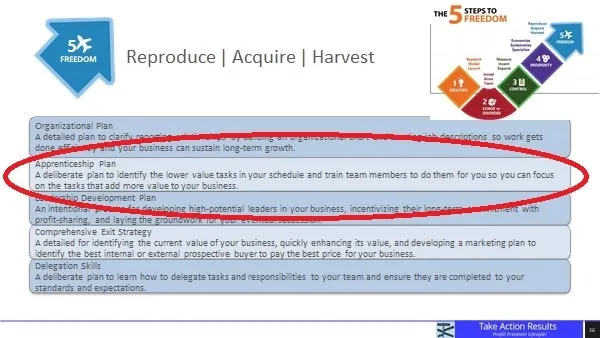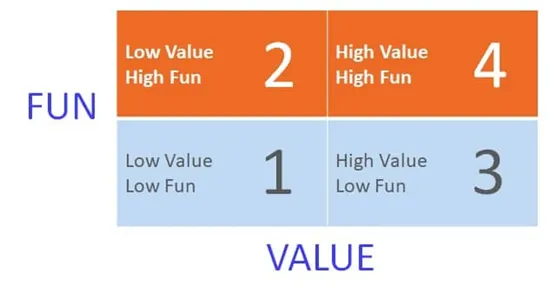Apprenticeship Plan
So what is an Apprenticeship Plan? It is a deliberate plan to identify the lower value tasks in your schedule and train team members to do them for you so you can focus on the tasks that add more value to your business. The number one reason that most business owners struggle to build a quality team that can run the business for them is because they don’t empower people. There are a couple reasons why they don’t empower people. Some business owners believe that no one can do the job as good as them so they get stuck working in and not on the business which limits growth dramatically. Also, many business owners have tried to empower people but did it poorly and it backfired and so they feel skeptical to try it again. Use this tip to think about doing a mental reset and doing it right this time around.
Why is an Apprenticeship Plan important? Having an Apprenticeship plan offers 3 key benefits to you and your business including
1. Creates the context to allow you to delegate more. To learn more about Delegation review that Business Team Tip by clicking here.
2. Creates a culture of employee empowerment and accountability.
3. Most importantly, it frees up your time to either focus on higher value tasks or take more time off.
The Apprenticeship plan is formally positioned on the Freedom step of the Five Steps to Freedom framework. You do not have to wait until your business is moving into the Freedom step to start to implement this plan but to actually be in the Freedom Step this plan must be fully in place.
How does your business stack up right now? Simply score your Apprenticeship plan from 1 to 5. A score of 5 means: ‘You and your team are actively coaching your direct reports on how to execute their responsibilities with increasing competence. New team members are systematically developed by their team leaders and a strong apprenticeship culture exists in the business’. A score of 1 means: ‘You and your team work in isolation from your direct reports. New team members learn how to execute their responsibilities on their own by trial and error. No apprenticeship culture exists in the business and everyone fends for themselves’.

So what is an Apprenticeship Plan? It is a deliberate plan to identify the lower value tasks in your schedule and train team members to do them for you so you can focus on the tasks that add more value to your business. The number one reason that most business owners struggle to build a quality team that can run the business for them is because they don’t empower people. There are a couple reasons why they don’t empower people. Some business owners believe that no one can do the job as good as them so they get stuck working in and not on the business which limits growth dramatically. Also, many business owners have tried to empower people but did it poorly and it backfired and so they feel skeptical to try it again. Use this tip to think about doing a mental reset and doing it right this time around.
Why is an Apprenticeship Plan important? Having an Apprenticeship plan offers 3 key benefits to you and your business including
1. Creates the context to allow you to delegate more. To learn more about Delegation review that Business Team Tip by clicking here.
2. Creates a culture of employee empowerment and accountability.
3. Most importantly, it frees up your time to either focus on higher value tasks or take more time off.
The Apprenticeship plan is formally positioned on the Freedom step of the Five Steps to Freedom framework. You do not have to wait until your business is moving into the Freedom step to start to implement this plan but to actually be in the Freedom Step this plan must be fully in place.
How does your business stack up right now? Simply score your Apprenticeship plan from 1 to 5. A score of 5 means: ‘You and your team are actively coaching your direct reports on how to execute their responsibilities with increasing competence. New team members are systematically developed by their team leaders and a strong apprenticeship culture exists in the business’. A score of 1 means: ‘You and your team work in isolation from your direct reports. New team members learn how to execute their responsibilities on their own by trial and error. No apprenticeship culture exists in the business and everyone fends for themselves’.
The key is to be completely honest with where your business scores on this 1 to 5 scale and then take the most appropriate steps to move towards a 5. These steps include
1. Read Zapp! The Lightning of Empowerment: How to Improve Quality, Productivity, and Employee Satisfaction. This is an amazing book and will really set your client on fire with the idea of empowering people well so that they gain their freedom from the tasks that they shouldn’t be doing.
2. Create a list of all tasks consuming your time and identify which quadrant of the Value/Fun matrix each task is located in. The Value/Fun matrix is the cornerstone of this Apprenticeship Plan. It’s a tool that helps you classify tasks based on how much value they have and how much fun they are. The Value/Fun matrix is predicated on the notion that a business owner is making the best contribution to their business when they’re adding as much value as possible and having the most fun doing it. The Value of a task is a purely economic in nature. The Value of a task is how much it would cost to get the task done on an hourly basis by hiring someone to get it done. It’s really not hard to know how much value a business owner is contributing to a business when doing a certain task because salary data for a given role is readily available online. The idea of Fun is predicated on the notion that when any of us find ourselves doing certain tasks “FUN” this is a huge indicator that we are in our sweet spot. When we’re in our sweet spot, we’re making excellent use of our natural wiring, so to speak. We’re leveraging our strengths and making the highest and best use of who we are. When we’re in our sweet spot, we’re going to produce better quality work which is good for us and our business.
3. Rank the list according to quadrants as follows:
1. Quadrant 1 - Low Value, Low Fun. As a business owner, you obviously want to spend as little time in this quadrant as possible.
2. Quadrant 2 - Low Value, High Fun. These tasks are a lot of fun, but since they don’t generate a lot of value for the business, they still should not be the main focus of the business owner. Better to have fun doing higher value tasks and offload Quadrants 2 tasks.
3. Quadrant 3 - High Value, Low Fun. These tasks are less fun, but full of value. These tasks are important because they add value to the business, whether or not the business owner actually enjoys doing them! Sometimes business owners just need to buckle down and get these done. Nevertheless, many of these tasks can still be delegated to an apprentice. This should be done whenever possible.
4. Quadrant 4 - High Value, High Fun. These tasks have the best of both worlds: lots of value and lots of fun! These tasks are obviously the most ideal tasks to be doing, the ones that the business owner will enjoy the most and also see the most reward from doing.
4. Consult your org chart and identify appropriate team members to apprentice in each of the tasks you wish to offload.
5. Serve as Master and take an Apprentice through the 4-Step Apprenticeship Process toward complete empowerment on each of the tasks you wish to offload.
6. Create an entry in the Operations and Training Manual (OTM).for each task as the task is learned. The OTM is another Business Time Tip.
The next step is to identify which team members to assign certain tasks to. When you’re delegating tasks within an organization, you always want to start at the bottom and work your way to the top. If you are big enough and have a leadership team or management structure in place you will need to work with your direct reports on this. Doing this will also encourage those direct reports to go through the same process to make better use of their time. To be able to accurately identify which people would be suited to being apprenticed in certain tasks, you should first have an org chart developed. We go into that in a separate Business Tip called the Organizational Plan.
When offloading a task through empowerment, the current task owner becomes the Master and will take their Apprentice through this 4-step plan. In the first step, the Master is doing the task while the team member Apprentice is simply watching. In Step 2, the Master is again doing the task, but this time the Apprentice gets to help and work alongside the Master. In Step 3, the Apprentice now takes on the bulk of the “doing” of the job, while the Master helps. And finally, Step 4, the Apprentice does the whole task with the Master simply watching and coaching. That’s it--that’s the 4-step Apprenticeship Plan! Super simple to remember. Now, after the Apprentice learns a task, it’s important that they create an entry for that task in the Operations and Training Manual (or OTM).
Finally, while you are implementing all these steps in the Apprenticeship Plan, make sure to fill out the Apprenticeship Plan Worksheet. This worksheet provides a single place to record every task and the apprentice who’s working on learning the task. You have to compile a list of all the tasks consuming your time. In this second column, assign what quadrant each task falls under. There is also a place to write down who is being apprenticed and what stage of the Apprenticeship Plan that team member is currently in. It is a really nice way to keep track of this process. Oh and by the way this worksheet can be managed and kept current by someone on the team like an administrative assistant or junior marketing person. If you would like the worksheet and would like to learn more about how an Apprenticeship Plan can help your business book a short phone call with me to chat.

The next step is to identify which team members to assign certain tasks to. When you’re delegating tasks within an organization, you always want to start at the bottom and work your way to the top. If you are big enough and have a leadership team or management structure in place you will need to work with your direct reports on this. Doing this will also encourage those direct reports to go through the same process to make better use of their time. To be able to accurately identify which people would be suited to being apprenticed in certain tasks, you should first have an org chart developed. We go into that in a separate Business Tip called the Organizational Plan.
When offloading a task through empowerment, the current task owner becomes the Master and will take their Apprentice through this 4-step plan. In the first step, the Master is doing the task while the team member Apprentice is simply watching. In Step 2, the Master is again doing the task, but this time the Apprentice gets to help and work alongside the Master. In Step 3, the Apprentice now takes on the bulk of the “doing” of the job, while the Master helps. And finally, Step 4, the Apprentice does the whole task with the Master simply watching and coaching. That’s it--that’s the 4-step Apprenticeship Plan! Super simple to remember. Now, after the Apprentice learns a task, it’s important that they create an entry for that task in the Operations and Training Manual (or OTM).

Finally, while you are implementing all these steps in the Apprenticeship Plan, make sure to fill out the Apprenticeship Plan Worksheet. This worksheet provides a single place to record every task and the apprentice who’s working on learning the task. You have to compile a list of all the tasks consuming your time. In this second column, assign what quadrant each task falls under. There is also a place to write down who is being apprenticed and what stage of the Apprenticeship Plan that team member is currently in. It is a really nice way to keep track of this process. Oh and by the way this worksheet can be managed and kept current by someone on the team like an administrative assistant or junior marketing person. If you would like the worksheet and would like to learn more about how an Apprenticeship Plan can help your business book a short phone call with me to chat. To your Success!
Other Posts
Apprenticeship Plan
Comprehensive Exit Strategy
Crisis Leadership
Delegation Plan
Employee Acquisition Plan
Leadership Continuum
Leadership Development Plan
Mastery Continuum
Metrics That Matter
Organizational Plan
Psychometric Profiling
Sales Continuum
Sales Management Plan
Success Continuum
Tactical Marketing Plan
Time Management Plan
Why A Coach?
© Action Leadership Inc. 2025
All Rights Reserved
624 Cantor Landing SW, Edmonton, T6W 0V6
